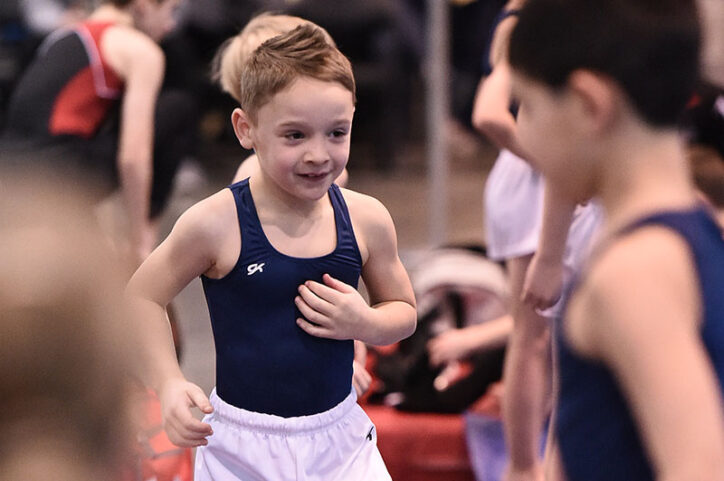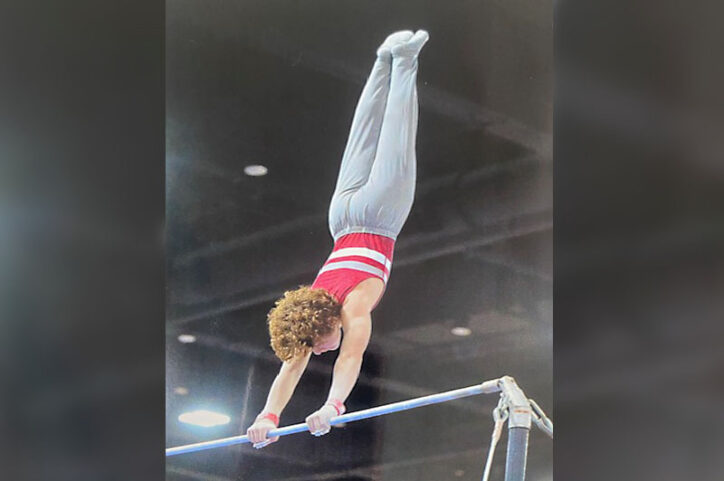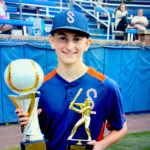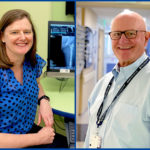A heavy-medaled gymnast and his close call with leg-length discrepancy

Ask 15-year-old Kaleb what he likes about gymnastics and with a sly smile, he’ll say, “flipping around.” That’s Kaleb: understated, funny. But watch him in action, and you’ll see a focused gymnast who earned two medals in the 2024 Men’s Eastern National Championships.
He probably won’t mention that two years ago, a surgeon told his parents he’d never be able to do gymnastics again.
A serious fall
Kaleb fell from the high bar during practice in February 2022. His parents rushed to the gym to find their son in the back of an ambulance. Dawn and Jeff soon learned that Kaleb’s femur (thighbone) was broken and severely dislocated. “It looked like his bone was next to his knee,” says Dawn.
At a hospital in Western Massachusetts, an orthopedic surgeon told Kaleb’s parents that the injury was the worst he’d ever seen. “He told us Kaleb would be lucky to walk or run again,” says Dawn. And gymnastics? No way.
“I am going back to the gym”
After surgery and five days in the hospital, Kaleb spent the next two months in bed. “I really liked it!” he jokes. “I got to play video games and my parents waited on me.”
Dawn, however, was distraught. At each follow-up visit, she asked the surgeon about Kaleb’s growth plate, which had been injured in the fall. (Growth plates are areas of cartilage at the ends of a child’s bones. A growth plate fracture can cause the affected limb to stop growing or grow crooked.) Yet at each follow-up visit, the surgeon said they’d need to wait six months to a year to know if Kaleb’s growth would be affected.
Much to everyone’s amazement, Kaleb was up and walking within two months. And he didn’t believe that he’d never do gymnastics again. “I don’t know why you’re so upset,” he told his parents. “I am going back to the gym.”

Gymnast to gymnast
Searching for someone who could help Kaleb achieve his goal, Dawn found a gymnastics medicine specialist, Elspeth (Elly) Hart, in the Sports Medicine Division at Boston Children’s Hospital.
“From the moment we met Elly, I knew we’d found the best place to give Kaleb a shot at returning to the sport he loves,” says Dawn. Like Kaleb, Hart was a gymnast, and she respected his devotion to the sport. She was also part of a team of orthopedic and sports medicine specialists skilled in treating severe injuries like his.
Hart prescribed a back-to-gymnastics protocol: a step-by-step plan to help Kaleb regain the strength and agility he needed to safely return to his sport. But seven months after his injury, he developed unexpected leg pain.
After a physical exam and discussion with the family, Hart ordered an MRI at a facility close to the family’s home. An MRI would provide detailed images of the soft tissues around Kaleb’s femur, including his growth plate.
A leg-length discrepancy in the making
The day after the MRI, Dawn received a jarring phone call from Hart, who had arranged for them to return to Boston right away. Both she and orthopedic surgeon Dr. Carley Vuillermin had reviewed Kaleb’s MRI. The growth plate in Kaleb’s injured left femur, she said, was almost fully closed.
Later that afternoon, Dr. Vuillermin told the family that Kaleb’s right leg was already slightly longer than his left. Without prompt treatment, he could develop a significant leg-length discrepancy, which could change his posture and put him at risk of future spine, hip, knee, and ankle problems. Further, Kaleb was entering adolescence, a period of rapid growth. The family needed to make a quick decision between growth arrest, a procedure that would permanently stop further growth in both of his legs, or limb-lengthening surgery on Kaleb’s injured leg.

Neither option sounded good: Stopping the growth in both legs on the cusp of Kaleb’s 14th birthday seemed monumental. But Kaleb didn’t want to have his left leg lengthened. “Leg-lengthening was too risky,” he says. “I wanted to be done with doctor appointments.”
After getting second and third opinions that confirmed Dr. Vuillermin’s assessment, the family decided on growth arrest.
It was mid-November and Kaleb wanted to postpone surgery until after Christmas. So in January 2023, Dr. Vuillermin performed growth-arrest surgery on the femurs in both of Kaleb’s legs: one to stop further growth in the uninjured leg and the other to prevent any deformity from developing from the injured growth plate.
Kaleb’s comeback
Kaleb walked out of Boston Children’s Hospital on crutches the day after surgery. Within a month and a half, he was working with a personal trainer, following the back-to-gymnastics plan Hart developed for him as Hart followed his progress virtually and in person.
Finally, in July 2023, Kaleb was strong enough to practice gymnastics again, just like he said he would. The following year, he was racking up medals at regional championships.
Kaleb takes his recovery in stride, but Dawn considers it nothing short of a miracle, one that she attributes to her son’s dedication to the sport and the treatment he received at Boston Children’s. “Boston Children’s was the place we needed to be,” she says.
Learn more about the Sports Medicine Division and the Limb Lengthening and Reconstruction Program.
Related Posts :
-

From injury to backflips: A path to recovery for gymnasts
Gymnasts can create the illusion that gravity doesn’t exist. As they spring from one acrobatic skill into the next, ...
-

Griffin's return to the slopes and sea after kneecap dislocation
Whether cruising down a snowy trail or catching a wave, 18-year-old Griffin Srokose loves the adrenaline and freedom he feels ...
-

A malunion fracture, baseball, and M&M cookies: Tyler’s story
Tyler Weygand loves baseball, and he’s good at it. Good enough that few balls ever get past him in ...
-

Limb-lengthening surgery: A look at the pros and cons
Limb length discrepancies, a leg or arm that’s shorter than the other, can occur for a number of reasons. ...





